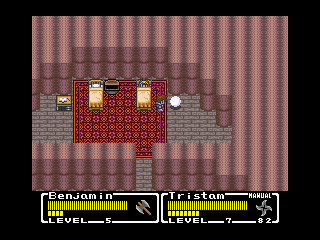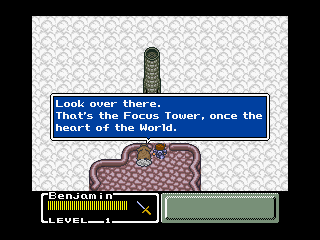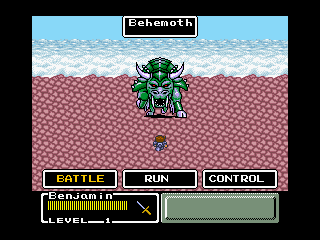 |
Final Fantasy: Mystic Quest - Retroview
|  |
RPG = Role-Playing, Rated G
By: Noj Airk
| Review Breakdown | | Battle System |
4
| | Interface |
7
| | Music & Sound |
9
| | Originality |
3
| | Story & Plot |
3
| | Localization |
5
| | Replay Value |
8
| | Visuals |
6
| | Difficulty |
Very Easy
| | Completion Time |
13-25 Hours
| | | Overall |

|
 | |
What do you see in the orb, Miss Cleo? |
|
A man once said: "A man is the sum of his memories," and when I think about a game like Final Fantasy: Mystic Quest, I suddenly realize how important my memories are when reviewing it. The fact that the game is almost eleven years old, and I was with it near the beginning, makes me smile upon thinking about it, just a bit...but...seriously, while not a terrible game, it really isn't good. Luckily, like going through an old attic, I was able to scrounge up enough material for an ever-so-slightly positive review.
This game has newbie written all over it. Unlike the first Nintendo game everyone played: Super Mario Bros., this game was far from ungodly hard, and friendly to those of its young target audience, who haven't yet self-evolved to having their thumbs being their primary, most agile digits. It's a nice breeze for even the most elementary of players, while there are still parts that are challenging to me today, an entire decade later. If you ask me, I think it's necessary to make more games like this…just, let's make it a bit better, okay?
The game's interface is clean and simple...very simple, that is. You move, can use items and magic, can use weapons to knock down doors and trees, talk, sleep, buy, and jump. Oh, yeah, and fight, of course. All of this is basic, except for a few of these; and that which is conventionally found in games is simplified further, such as fewer people to talk to, and the item type amount being much, much smaller. Most locations are also somewhat small, especially at the beginning. Smartly done by Squaresoft, as one progresses through the game, the locations become progressively more and more mazelike, and complicated. In fact, the Volcano, where you fight the fire fiend, is still the most complicated and time-consuming maze I've ever come across. While frustrating, I do put its amazing complexity as a serious pro to the game's status.
Tragically, while I say that for young audiences the limited interface was a good thing, the limited and simplified battle system isn't the same case. Actually, it sorta backfired. Having two characters in battle at a time is just too little; especially how Final Fantasy IV is still the only Final Fantasy to have five, which was only a year earlier. Not to mention, that game was also cleaned up from its darker plot to make it more acceptable for younger audiences, so did they not consider that game to still be too advanced? With few items, and the battles usually being between easy and too easy, "going overboard" with making it simple, is somewhat of an understatement of the simplicity of the battle system.
 | |
Yes, forget what you heard about Rock music, or what that religious freak told you in front of the pizza place: this is the real heart of the world! |
One good example of simplicity in the battle system is that there are only twelve spells, which are universal between characters. Also, the main hero is the only one who can willfully change weapons, and he only has four to choose from. All have different aspects and attributes, but you'll really just use the one that does the most damage. Also, on each level, the amount of damage you and your friends either give or receive is a constant integer, unless it's one of those rare super attacks or a clean miss. The battles are no longer fully random, as you can see all of the enemies before engaging them. However, Square smartly made them guard either items, or paths of advancement. The one real innovation, however, to the combat system, is that when an enemy is hurt, the more you hurt it, you can see as the image of it changes; a feature that I haven't seen since. Hopefully in the new era I will start to be able who's weak by more than just cartoonish damaged sprites, but wounded stances, AI deciding to fall back, or perhaps even blood.
What makes the game ultra G-rated would have to be the simplicity of the writing, however. True, one cannot expect much with either a past NES RPG, nor during a time of heavy censoring. However, while softly-written games of the general time such as Final Fantasy IV or Destiny of an Emperor had easy-going dialogue in it, the potential of the plot and screenplay called for much more potential. In this screenplay, you'd have to take the friendly script, and more than triple it in size to make it dark, as it's not only happy, but amazingly short in length and character depth. However, since the targeted audiences are young and usually imaginative, it'd be easy enough for them to gain a liking for these characters anyway, just like I did when I was playing it, about nine years old. Being a scriptwriter myself, I commonly write, look back, and suddenly realize just how far I really have to go sometimes (in terms of professional ability). Sometimes, with the real epic games, I also find this type of "perhaps the game writers truly are much better than me" thought, but in Final Fantasy Mystic Quest, I practically feel up there with Kevin Smith and Shakespeare.
With such weak writing, it's a wonder the story made it intact...well, until you actually play through it. Frankly, while in nice small-epic size, mostly during its early SNES release date, it's really a story that could have stayed at its level of magnitude if sprites told us the story by playing charades. Storywise speaking, that's where we imaginary writers feel proud; it's the fact that we can write a story better than a Final Fantasy out there. The story is extremely small and childish, only somewhat inventive, and remains a mystery as to how this game spans a good 20 hours of play. Due to the far less impressive emphasis on plot when compared to Final Fantasy IV, and that the plot is primarily unoriginal, many simply don't acknowledge Mystic Quest as an actual entry to the series.
However, while the plot wasn't very well written, the same cannot be said about the music within this title. I'm pretty sure that Nobuo Uematsu wasn't involved in the musical aspects of this game, but this is one of those times, like Final Fantasy Tactics, where frankly, it doesn't matter at all. I stand as one to say that Final Fantasy Mystic Quest holds some of Square's greatest musical pieces ever. Tracks like the ones inside Doom Castle and the multiple battle themes have a hard rock edge that somehow remains epic, while tracks like the temple tracks are beautiful, and the Focus Tower theme is heroic and catchy. Each cave has its own track, each one just screaming of wonder, and the final battle theme is quite possibly the most well composed last battle theme pre-Dancing Mad (Final Fantasy VI's end battle theme...a four-part track), because it holds the emotion of any other powerful track ever written, and is truly almost twice the length of the infamous Zeromus track! Frankly, to me the replay value of this game is decently high simply because this game is easy, and has a mind-blowing musical score! I would play through it every year or two like clockwork if I only had a SNES in my dorm room. If only the MIDI was at least as good as that of Final Fantasy's IV & VI.
 | |
Okay, okay, so maybe not ALL the battle locations look good. |
Finally, the graphics in this game continue the simplicity, while they are in some ways a nice step up from Final Fantasy IV's…that is, much more than Final Fantasy V's were. The monsters look very good, change depending on the amount of life they have, the maps use nice SNES depth-of-field effects, the spells and battle locations look quite good, and the color palette has increased in use. However, there are several reasons I only ranked the visuals department a six out of ten. One is that Final Fantasy IV was made a full year earlier, and while this is an improvement, it isn't as much a year's graphical improvement should be; just look at Secret of Mana over this, for that was one year later too. Second is that the monster count doesn't seem anywhere near as high as that of the monster SNES FF before it, so now monsters are recycled more often than before. Thirdly, in the Tower of Babil in FF4, lights glowed blue, and the pits around the paths you walked believably went forever. There was none of this cool artistic-ness, or wonder involved in the game's graphics select the nice SNES 3-D effects when on a mountain. And finally, when in battle, the squat characters remain squat, without transforming into the taller, more elaborate warriors, and nor were any of the location palettes or 3-D design at all superior to anything before.
Having to select a more professional score for this game, I'd have to rank it a five out of ten, since I find it hard sometimes to analyze this game without my mild sentimentalities getting in the way. Like I said, I could play this game over and over every few years until the day I die, but that doesn't justify any reason for anyone else to have to attempt to enjoy it. They may not. For all interested in simply having one more RPG beaten and under their belt, or a great MIDI soundtrack, and those who aren't afraid to look a lousy plot in the eye and accept it should possibly give Mystic Quest a fair shake. For others, just skip over it, unless you must possess every Final Fantasy ever made...like me.
|







